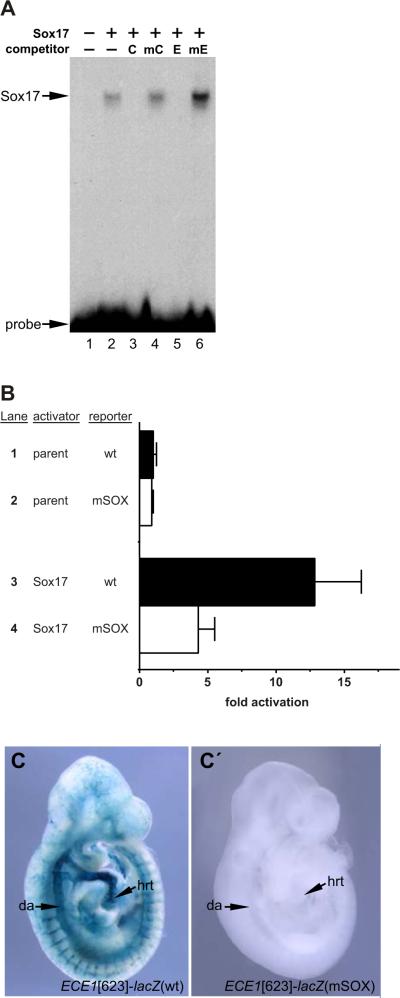FIG. 5.
The ECE1 enhancer contains a bona fide SOX site. (A) EMSA using a radiolabeled double stranded oligonucleotide probe corresponding to the ECE1 SOX site. Recombinant Sox17 bound to the probe (lane 2). Addition of excess unlabeled control SOX site [C] or the ECE1 SOX site [E] abolished binding (lanes 3,5). Unlabeled mutant versions of the SOX sites [mC, mE] did not compete for Sox17 binding at ~100-fold excess (lanes 4,6). Unprogrammed reticulocyte lysate is shown in lane 1. Free probe is denoted. (B) Cos-1 cells were co-transfected with pRK5 expression vector (lanes 1,2) or with pRK5-Sox17 (lanes 3,4) and the wild type [wt] ECE1-TK-β-gal reporter (lanes 1,3) or a version of the reporter with a mutated SOX site [mSOX] (lanes 2,4) and assayed for β-galactosidase activity. Sox17 strongly activated the reporter (lane 3) and this activation was largely dependent on an intact SOX site (lane 4). Data are expressed as the mean fold activation plus SEM for 3 independent transfections and analyses. (C, C’) Wild type [wt] ECE1[623]-lacZ (C) or ECE1[623]-lacZ with a mutated SOX site [mSOX] (Cc) transgenic embryos were collected at E9.5 and were X-gal stained to detect E-galactosidase activity. The wild type enhancer was active throughout the arterial vasculature (7/9 independent transgenic lines; 2 lines showed little or no expression). Mutation of the SOX site completely abolished all activity in all 3/3 independent transgenic lines examined. Representative transgenic embryos are shown. da, dorsal aorta; hrt, heart.

